Aside from basic survival necessities like food and water, a prepper also needs to consider having a stock of gas handy.
When things go awry, having ample gas reserves could become a key factor to your survival. Your stock of gas can help you not just to survive but thrive in any SHTF scenario.
Still, you can’t just store gas in a random container and leave it in your shed. Gas has an expiration date, and not following important rules when storing gasoline can compromise your gas reserves or, worse, become a safety hazard for you and your family.
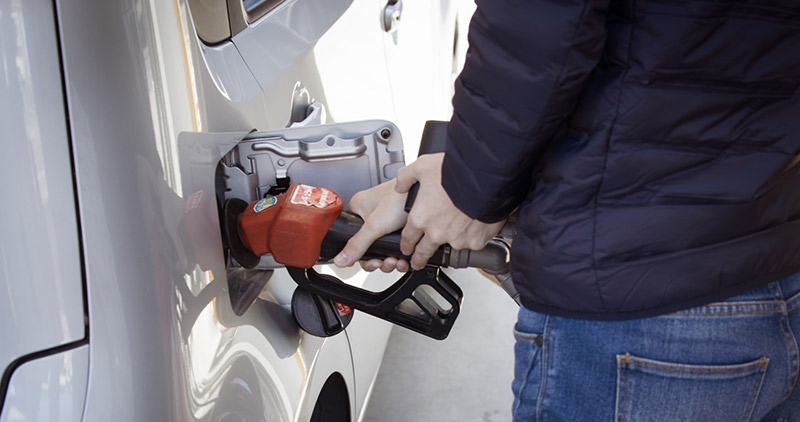
But before you go ahead and start storing gas, make sure to go through this guide first.
Why Store Gas?
In today’s modern age, many machines and appliances that we have come to rely on use gasoline as a power source.
If you decide beforehand to keep a stock of gasoline handy, you will have ample supplies to power your generators and vehicles. Thus, such preparation will allow you to thrive in an otherwise bleak scenario.
Unfortunately, if an SHTF scenario does happen, it will only become increasingly harder to get hold of gasoline as time passes.
That’s why putting gasoline in your prep list should be one of your priorities, especially if you want to make use of your car or generator.
Here are some of the reasons you should start stocking up on gasoline now before it is too late!
1. Increasing Prices of Diesel Fuel And Other Gasoline Variants
Gasoline prices have continuously been on the rise lately. With that said, stocking up during fuel price rollbacks would allow you to save some money in the long run, provided that you properly store your gas.
2. For Emergency Use Vs. Going To A Gas Station
A reserve of gasoline can come in handy during emergencies. If your vehicle is about to run out of gas, you can count on your readily available gasoline reserves instead of going to a gas station to refill your containers.
Truly, a personal gas stock can come in handy during a crisis.
3. Stored Gas Maintains Power During Outages
More and more people and entrepreneurs have acquired generators to power their homes and businesses in a blackout.
Since these generators typically run on gas, it is necessary to have a gas stock readily available if they need to be used.
It’s also necessary to operate your generator for a few minutes every week to keep it maintained, fresh, and ready to be used at any given moment.
How Long Does Gas Last?
Gas is composed of multiple substances. Over time, these substances can split apart, evaporate, or degrade.
Basically, gas has an expiration date. However, not all gasoline is created equal, leaving us to ask how long gas last.
Ethanol-blended gas lasts up to three months
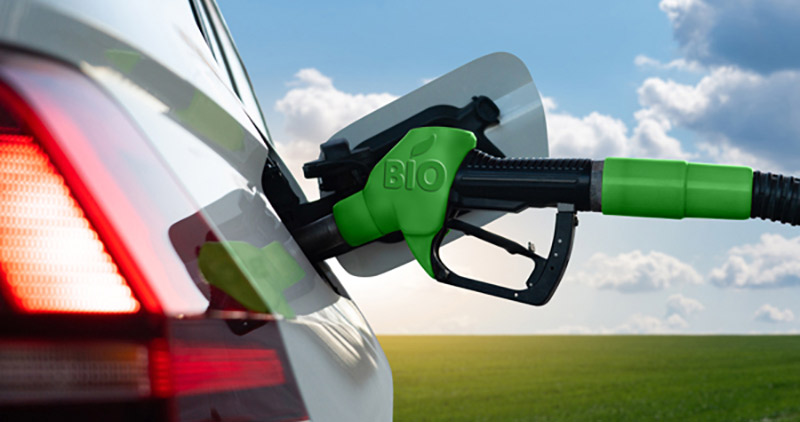
The Energy Information Administration of the United States reports that most gasoline sold in the U.S. is “E10” gas.
The gas comprises 90 percent petroleum-based gas and 10 percent ethanol (ethyl alcohol). Regular gas usually lasts up to three months before going bad due to the high oxidation speed of ethanol.
The hydrophilic nature of ethanol means that it will readily absorb water or humidity in a sealed container due to condensation, causing both moisture contamination of the gas and, eventually, the separation of your gas into distinct ethanol and gas layers.
It usually takes about a month before an ethanol-blended gas stored in optimal conditions starts to lose combustibility.
Pure gas is good for three to six months
Pure gasoline, or 100% petroleum-based gasoline without any ethanol, is still liable to succumb to the effect of oxidation and the evaporation of volatile compounds despite being placed in a sealed container or tank.
Fortunately, these processes occur significantly more slowly in pure gasoline. It means that if you take care to store your gas reserves properly, you can expect them to last at least six months.
The hydrophobic nature of pure gasoline means that it will not absorb water or humidity compared to ethanol-blended gas.
Consequently, you won’t need to worry about moisture contamination and gas separation issues.
Fuel-stabilized gasoline keeps for one to three years
Fuel stabilizers are petroleum-based additives mixed with fresh fuel before storing them in a fuel container.
It works by slowing oxidation and volatile compound evaporation and ultimately extends the shelf life of the stored fuel.
A fuel stabilizer allows you to extend the shelf life of your gasoline reserves between one and three years, depending on the stabilizer you’re using.
Keep in mind that stabilizers should be used with fresh gas since they are ineffective at slowing the degradation of old gas, and they can’t magically return contaminated gas to a pure, working one.
How to Properly Store Gasoline
By following the simple instructions listed below, you’ll have a much better chance of properly storing your gasoline long-term and preventing bad gasoline from entering and damaging your internal engine components.
Store Gasoline In A Cool and Well-Ventilated Area Away From Any Possible Ignition Source and Out of Reach of Children
Whether you decide to store your gas in your attached garage or a detached shed, the area must be fairly cool (shouldn’t get hotter than 80 degrees Fahrenheit), well ventilated, at least 50 feet away from an ignition source (e.g., pilot lights), and out of reach of children.
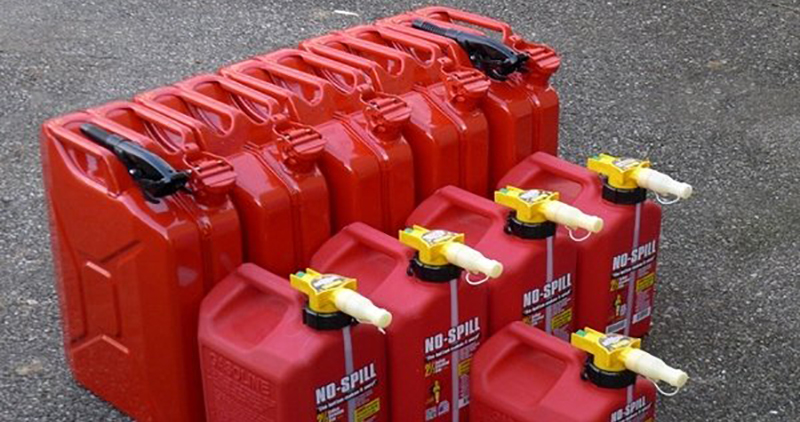
Following these steps will significantly reduce the chances of a fire starting or your children gaining access to and playing with the gas.
Always Have An Accessible Fire Extinguisher Near The Gas Storage Area
Should a fire start from your gas storage, you must have something in the area to put it out quickly.
Always keep a fire extinguisher in an accessible location inside your gas storage area. Make sure you regularly orient yourself on how to operate it effectively.
Use a Steel Gas Can
If you seriously want to extend the life of your gas, investing in steel gas containers is an effective way of doing so.
While plastic gas cans may be cheaper, they don’t do a good job of blocking air, direct sunlight, and water vapor from entering the container and contaminating the fuel inside.
Meanwhile, steel gas cans are designed with thick steel walls and a rubber gasket. These components keep gas fresh while helping it avoid moisture contamination. Steel gas cans are also adept at preventing contamination and vapor loss.
If you live in warmer environments, steel gas cans are the ideal fuel storage containers since the expansion and contraction of gasoline will not wreak havoc to steel containers the same way it does to a plastic container.
It’s still recommended to keep gas in a metal gas can that your local fire department has approved.
Set Aside a Small Amount of Empty Space In Your Container
Whether you’re thinking of storing gasoline for long-term or short-term use, it’s always essential to leave a small amount of space inside your containers if the temperature reaches a point where it influences gas to expand in size.
That space you leave in your containers may prove to prevent the unnecessary build-up of pressure if the temperature ever reaches too high one day.
Another benefit of setting aside some space in your fuel container is significantly preventing spills and overflow. Thus, it will reduce the opportunity for condensation to form inside the container.
Please remember that leaving too much leftover space may do more harm than good as it can allow more moisture and air to contaminate your fuel and reduce its lifespan faster.
That’s why experts recommend filling your containers up to 95% full as it can provide sufficient room in case gas expands without allowing an unnecessary amount of oxygen inside.
How to Tell if Your Gas Has Turned Bad
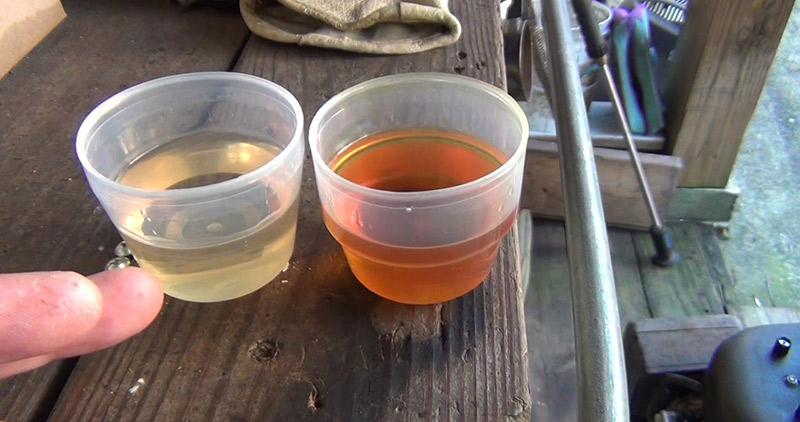
As gas ages, its chemical property slowly starts to change. Consequently, your engine will have a more difficult time processing fuel correctly when you use old fuel instead of new fuel.
That’s why you should watch out for several indicators to determine if your gas has become bad.
The simplest method is your “check engine” light. If your vehicle is running with no issues and your engine has oil, then improperly burning gas may have triggered the check engine light because your engine is not burning the gas properly.
It’s better to take your car to a certified mechanic or a dealership to investigate and determine if bad gas is the problem.
If your car suffers from operational problems, that is another key indicator that your gas may have gone bad.
These problems may include failure to start, a rough-sounding idle, a hesitant ignition, or a loss of power while driving, particularly when accelerating.
You can also determine the state of your gasoline by how it looks and smells. Bad gas will have a darker or muddier look. You’ll also notice a distinct sour or disagreeable odor that is not present in normal fuel.
If you have discovered that your gasoline is indeed bad, disposing of it is your best decision.
Choosing to use bad fuel to save money will inevitably cost you in the long run as it can corrode your engine and gas tank, leading to costlier repairs.
How To Prevent Your Gas From Going Bad
Fuel Stabilizers Extend Gasoline Life
Fuel stabilizers won’t cost you much. You can purchase these products in your local gas stations, auto stores, and retail stores.
Applying the fuel stabilizer additive is also easy since you need to pour it into your fuel tank or whatever container you use for storing fuel.
The stabilizing agent works by neutralizing chemical reactions that break down gas over time.
Most gas stabilizers only need to be used once to ensure your fuel lasts for a year.
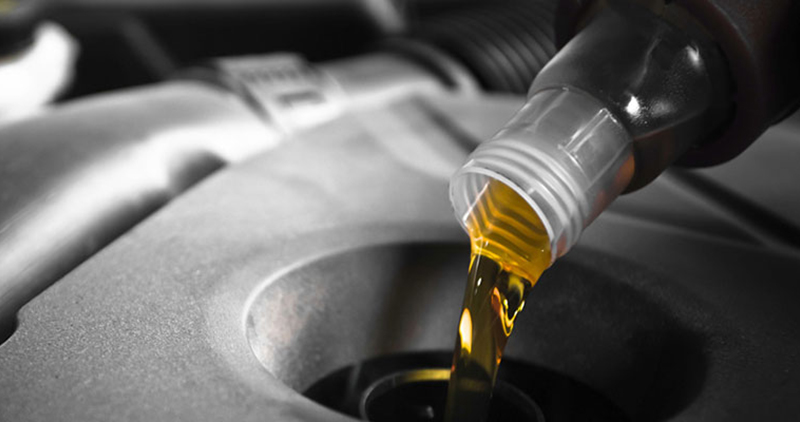
At the end of the year, we recommend using this stored gas and refilling it with new fuel, but you can also redo the stabilizer treatment to extend the shelf life of your fuel for another year.
Make the Use and Replace Technique a Habit
Make the First-In-First-Out concept a habit to make sure you fully take advantage of your properly stored gas reserves.
This method works well for gas storage, especially if you don’t want the added expense or effort of using a stabilizer or if you want a large reserve of gas but can’t use a large tank because of space issues or other reasons.
Most people typically possess only one tank, the gas tank in their car. They would commonly wait until their car’s tank gets low, fill it up until you have a full tank, use the fresh stuff, and repeat the same process.
Alternatively, you could store a few full cans of gas in your garage and top off your car with the oldest gas container you have.
As you use the gas stores in your garage, you take the empty cans to the gas station and refill them. You can label the canisters to make it easier to track how old each fuel canister is.
This method doesn’t require a total habit change, so it’s fairly easy to do. You won’t need to get your hands on a stabilizer as long as you properly schedule your gas.
